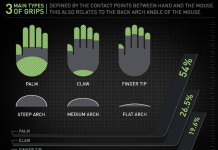Today video games involve a lot of rapid mouse clicking, so in this infographic you will learn how to modify a mouse to add a rapid fire button to it. That way we can easily activate the rapid clicking function, by simply pressing one button.
Step 1: Materials
Here are the materials that you will need for this project.
Materials:
Mouse
555 Timer IC
10 µF Capacitor
4.7 kohm Resistor
Diode
Jumper Wires
PC Board
Small Momentary Switch
Heat Shrink Tubing
Step 2: The Timer Circuit
The circuit that I built uses a 555 Timer IC, to send a series of pulses to the left mouse button to activate and deactivate the clicking function. The frequency of the Timer Circuit is determined by the values of the resistor and capacitor and equals to Frequency = 0.72 / (RxC). With the values that I used, the rate was about 15 clicks per sec. Power for this circuit is supplied by the 5 volt line from the computer USB port, which also powers the mouse. The output of this circuit is a series of pulses that are equivalent to 5 (High) and 0 (Low) volts. To prevent circuit form the shorting out, a small diode is added to the output in case if the rapid fire button and the left mice button where ever pressed at the same time. A small momentary switch serves as a rapid fire button, which is added on the left side of the mouse.
Step 3: Prototype and Test
First start prototyping the circuit on a breadboard, to test it you can connect it to the mouse with alligator clips. You need to connect pin 4 and 8 on the timer to one of the 5 vault pins on the mouse, then connect pin 1 on the timer to one of the ground pin on the mouse. Lastly connect the Diode from pin 3 to the momentary switch and connect that to the terminal on the left mouse button, that is not connected to 5 vaults. Once you have done everything as it is shown on the infographic, then you are ready to connect and test whether your circuit is working or not.
Step 4: Identifying the Positive and Negative Terminals on the Mouse
Before you can connect the 555 Timer IC circuit to the mouse, you need to identify the positive and negative terminals on the mouse. The easiest way to locate the terminals is to follow the connections from the USB port. You can also use the multimeter to check which terminals are connected to each other. If do not have such instruments there is a step by step guide which highlights main parts of the circuit, so you can easily identify the negative and positive terminals on the mouse.
Step 5: Connect the Breadboard Circuit to the Mouse
If you have already identified the positive and negative terminals it is time to wire the breadboard circuit to the mouse by connecting the corresponding terminals of each one together (For example: Connecting negative terminals of the mouse, to negative terminals on the circuit). You also have to connect the output wire of the circuit to the terminal of the left mouse button, that is not connected to positive. For now everything is connected using alligator clips, in order to avoid any mistakes until we start soldering.
Once everything is connected, you can test it by plugging the mouse into a computer and pressing the rapid fire button. If it is working properly, then the computer should register a series of clicks from the mouse.
Next, solder the timer to the mouse at the same points that you connected to earlier. When you are done soldering, trim the circuit boards that only as big as the components. Then find a convenient place on the mouse to mount the button, I chose to put it on the left side because there is already a whole there for the wires. The last thing to do before putting it all together is to wrap the timer and tape it to help avoid short. Now just fit everything in place and close up the house to test out the rapid fire button.
Step 6: Soldering the Circuit
If the breadboard circuit works and your computer identified the rapid fire button, only then you can solder it together on a circuit board. As there is a very little space inside a mouse, you need to make it as small as possible to be able to fit it inside the mouse.
The switch is not mounted to the board, as it’s a separate part of the build. It will be mounted to the outside of the mouse and connected to the board using couple of small wires. Once all the necessary parts are added to the board, you should cut off any extra part of the board with Rotary Cutting Tool that sticks out past the components.
Step 7: Connect the Timer Circuit to the Mouse
If you have done soldering, now it’s time to connect the timer to the mouse. Easiest way to do that, is to solder the timer to the mouse at the same points that you connected to earlier, when you are done soldering trim the circuit boards that only as big as the components.
Step 8: Mount the Circuit Inside the Housing of the Mouse
Next step is to mount the circuit board into the mouse, which can be little bit tricky, because the housing of the mouse is really small. Try to find a spot that has enough room for the circuit board. In order to fit the circuit you have to cut away some of the extra (not needed) plastic parts. If the circuit board of the mouse has any exposed metal near where the Timer IC circuit will be mounted, you may want to wrap the circuit in tape to avoid any possibility of a short.
To mount the switch, find suitable place on the outside of the mice, that would be easy to reach while playing your favorite games or browsing the web. I have decided to place the button on the left side of the mice where my thumb rests.
Step 9: Testing The Rapid Fire Button
Now just plug the mouse into your computer and you are ready to use. To test out the rapid fire button, I found a simple flash game that measures how quickly you can click, it calculated that I was clicking over 800 times per minute. Normally is was able to click at a rate of about 400 clicks per minute, the result is pretty unique as it doubled my clicking rate.
Step 10: Modifying The Design For Console Controllers
This design can also be used on console video game controllers, the only thing that you need to modify is the orientation of the Diode. The buttons on the mouse connect 5 vaults to activate the function, but the buttons on a console controller typically connect ground. So you just need to reverse the Diode, so that the output is a series of low pulses, instead of high pulses. Well that is how to make a rapid fire button for your mouse or console controller.
Materials: Tools:
Mouse Soldering Iron
555 Timer IC Wire Strippers
10 µF Capacitor Knife
4.7 kohm Resistor Rotary Cutting Tool
Diode Multimeter
Jumper Wires
PC Board
Small Momentary Switch
Heat Shrink Tubing





